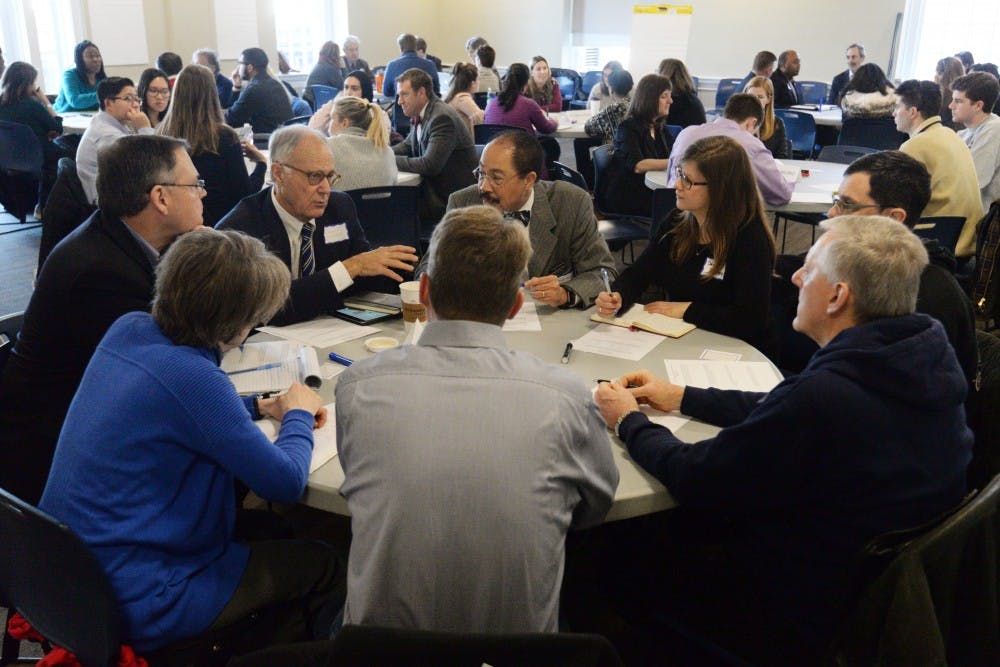During their public input session Friday, the Advisory Committee on the Future of the Historic Landscape welcomed feedback and suggestions from members of the University community. Approximately 50 people came together to discuss potential actions the University could take to memorialize its storied history. The advisory committee is an offshoot of the Deans Working Group, which is the coalition of prominent community members formed by President Teresa Sullivan in the wake of the events of Aug. 11 and 12. Tasked with responding in both the short term and long term, the working group advises the University administration on potential actions to strengthen and examine our community. Within six months of creation, the working group has contributed to the bolstering of the University’s open flame policy, expanded Ambassador coverage and designated the Lawn a “facility.” While these accomplishments speak to the potential of the working group, their establishment of the advisory committee only detracts from the group’s ability to succeed.
In an email sent last Thursday, Risa Goluboff, Law School dean and chair of the working group, updated the community on the group’s progress and announced the establishment of the advisory committee. She described the committee’s responsibilities as working to “formulate principles and make recommendations about the display of visible historic symbols on Grounds.” The committee is comprised of people who have interacted with the University in a variety of capacities, including past and present students.
The establishment of the advisory committee distances the working group from a vital part of the group’s work. The modifications made to Grounds itself will serve as symbols of the strength of our community, and as the body primarily charged with building that strength, the working group has a responsibility to directly engage with the community. Instead, the advisory committee is conducting the grassroots research through events like the public input session last Friday, and through input from the community online. While the committee is comprised of competent and driven individuals who will offer meaningful suggestions to the working group, the working group’s direct execution of this charge would lead to more effective change at the University.
Leading the study of historic displays on Grounds would benefit the working group’s relationship with the greater community. In the event last Friday, students, faculty and staff had the opportunity to work closely with committee members. Each table of participants included at least one member who facilitated a discussion about the implications of the committee’s work. The dedication and passion shown by these committee members impacted the participants — attendees testified to the committee’s investment in their work. The working group missed an opportunity to forge a positive relationship with the public by not leading these efforts itself.
The establishment of the advisory committee will only bog down the University’s process of reckoning with its own history. While the committee members may have much to offer to the working group, each of them could have contributed to the process without heading the task themselves. The working group could have interacted with committee members through interviews and focus groups, which would still benefit the process and mitigate the problems associated with delegating this entire task. The large bureaucratic costs of having the advisory committee propose suggestions to the working group, who in turn will propose suggestions to the administration, come from the potential to lose important information or viewpoints in translation between the three levels. In addition, there is some redundancy in the tasks of the working group and the advisory committee, which contributes to an inefficient allocation of resources. The working group should merge the committee into the broader group, in the hopes of retaining the viewpoints and skills of each committee member while also demonstrating their deep investment in the process of evaluating the University’s current state.
If the working group plans to invest fully in its own mission, its members need to be on Grounds listening and engaging in the discussion of historic displays — not receiving a report from those who did the work themselves. Although this task is just one part of the group’s greater mission, the actions taken by the administration to address it will leave a lasting mark on the University, both as a physical space and as a community. The working group should reevaluate its decision to delegate this task to the advisory committee in an effort to accomplish its goal of strengthening the University and its broader community.







